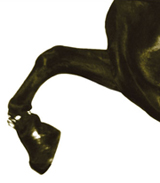Shelbyville, Tennessee bills itself as the “Walking Horse Capital of the World,” and it was the Tennessee Walking Horse National Celebration there earlier this month that drew federal, state and local law enforcement officials, as well as national headlines.
Then in a bizarre twist, on September 8, the Tennessee Department of Health (TDH) began an effort to notify the approximately 150,000 spectators and participants who attended the Celebration of a confirmed case of rabies in a horse stabled on the show grounds.
Located 50 miles southwest of Nashville, Tennessee, Shelbyville, population 16,000, annually reins in $38 million for the local economy through the 11-day Celebration that culminates with a grand championship finale. This year, however, the event ended without a championship, after five out of eight contenders for the title of grand champion were disqualified by USDA inspectors because of evidence of abuse – specifically “soring.”
 Tennessee Walking Horses are known for their unique four-beat gait and an over-stride that accentuates high-stepping front leg action. Soring refers to techniques, including the use of constrictive chains and caustic chemicals, to artificially enhance a horse’s front leg action. The practice was officially banned when Congress passed the Horse Protection Act in 1970.
Tennessee Walking Horses are known for their unique four-beat gait and an over-stride that accentuates high-stepping front leg action. Soring refers to techniques, including the use of constrictive chains and caustic chemicals, to artificially enhance a horse’s front leg action. The practice was officially banned when Congress passed the Horse Protection Act in 1970.
According to Chester Gipson, USDA deputy administrator for animal care, the Tennessee Walking Horse community has been lax in its responsibility to regulate and police their own shows in an effort to eliminate the practice of soring. In response to fallout over this year’s Celebration, the Tennessee Walking Horse Breeders and Exhibitors Association (TWHBEA) called a special meeting of their board of directors and presented members with a plan that features reformed rules and judges’ procedures, and also created the new position of director of animal welfare.
Six days after the conclusion of the Celebration, the TDH and Centers for Disease Control and Prevention (CDC) sent out an alert for those who might have come in contact with the rabid horse, a buckskin gelding stabled on the show grounds.
The three-year-old gelding, from Waynesville, Missouri, was first noticed to be ill on August 28 and, over the next few days, developed severe neurological symptoms and was euthanized.
TDH officials say that the potential for public contact with the gelding was very limited when he was in his stall, but there might have been the opportunity, when he was ridden on the show grounds. If people were bitten by him or came in contact with his saliva, they could have been exposed to rabies.
Humans are exposed to the disease through the bite of a rabid animal or when the saliva of a rabid animal is introduced through fresh open cuts in the skin or onto mucous membranes, such as the eyes, mouth or nose.
Although comparatively rare in horses, the CDC confirmed 51 cases of rabies in horses, donkeys and mules in 2001. Transmission of the disease to horses usually occurs when they are bitten on the lips or nose by rabid skunks or opossums.
